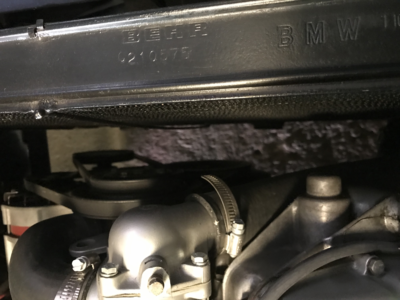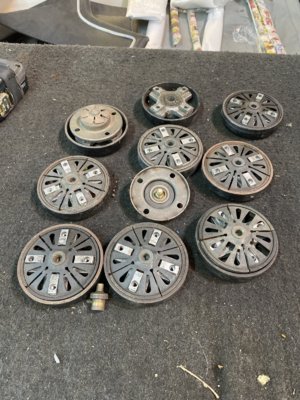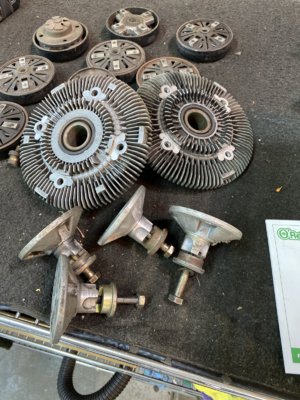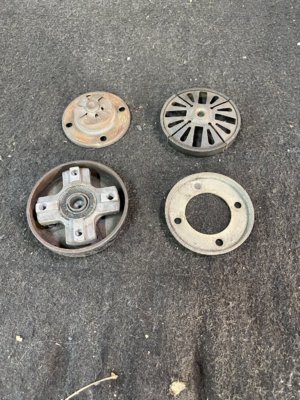You are using an out of date browser. It may not display this or other websites correctly.
You should upgrade or use an alternative browser.
You should upgrade or use an alternative browser.
Original fan clutch
- Thread starter wolfram
- Start date
Hi
Fan clutch 11 52 1 251 821 is discontinued and no way for a second hand --too risky.
You should change for symetric fan and visco coupler commonly used as option

Marc
Fan clutch 11 52 1 251 821 is discontinued and no way for a second hand --too risky.
You should change for symetric fan and visco coupler commonly used as option

Radiateur — thermostat/ventilateur
Radiateur — thermostat/ventilateur | BMW 2.5CS-3.0CSL 3.0CSi M30 l'Europe
fr.bmwfans.info
Marc
With the newer viscous clutch you need the mount with four bolts and one center bolt and a new fan that fits that water pump with the square/symmetrical mounting holes on the impeller. The newest water pump is different and that clutch uses the impeller and fan pulley with rectangular arrangement, not square, and has one large 32mm mounting nut, they are not interchangeable.
How to shim it:
 e9coupe.com
e9coupe.com
Overheating
OK It is actually pretty simple, remove the fan clutch housing and in the center of the clutch brake, just add a thin /thick shim where the the thermo coupling pushes against The clutch material wears and the thermo coupling as it ages doesn't push as hard as when it was new Adding...
 e9coupe.com
e9coupe.com
No I don’t. Please till me.You know how to shim one?
Are those on the pic for sale?
Thanx for rapid answer/ pow
Available at partsfrog in Germany. Second hand.Hi!
Where can I find a new fan-clutch suitable for this beautiful asymetric fan?
E9 1975 CS
Best Regards/ CoupeView attachment 139142
https://partfrog.com/products/bmw-e3-2-5-2-8-3-0-m30-kupplung-lufterrad
We have the same red fan and on our 70 2800cs the past owner eliminated the coupling and now just have a solid aluminum spacer. Car has run fine for 25 years this way. Now the car is apart for restoration.
So we ask the question why is a fan clutch even needed? We live in Fl and AC is used most of the year. So would not having the fan spinning all the time make sense for better cooling? What am I missing? Anyone else running the fan direct? If so any long term consequences?
Thanks
jjs2800cs
So we ask the question why is a fan clutch even needed? We live in Fl and AC is used most of the year. So would not having the fan spinning all the time make sense for better cooling? What am I missing? Anyone else running the fan direct? If so any long term consequences?
Thanks
jjs2800cs
tochi
Well-Known Member
- Messages
- 189
- Reaction score
- 93
Turning your question around, do you think there might have been any advantages to originally equipping your vehicle with a fan clutch? Perhaps . . . there are times when a cooling fan is not needed. Consider the situation where a vehicle is driven at highway/autobahn speeds and there is plenty of air moving through your vehicle's radiator. Related fan clutch advantages include: reduced noise, quicker engine warm up (especially in cold climates), improved fuel economy and reduced parasitic power loss. Consider also that at higher road speeds, depending upon engine speed as dictated by gear selection and axle ratio, a clutchless mechanically driven cooling fan might actually be working against the normal flow of air through the radiator.
You mentioned air conditioning in your vehicle. Is it possible that your vehicle is also equipped with a secondary electric fan - to supplement the volume of air flowing through your air conditioner’s condenser - as well as your vehicle’s radiator? Ordinarily, that electric fan would only be needed when using the vehicle’s air conditioning.
If you spend considerable time in slow, stop-and-go traffic - where there is limited air flow through your vehicle's radiator, the fan clutch would likely be engaged most, if not all, of the time. So, the long term consequences, given that scenario, are negligible. Also in your favor is the fact that the E9's little brother, the 2002, did not employ a fan clutch. This choice was probably dictated due to added cost, lack of space and additional weight. Some might argue that the more utilitarian 2002 was and is noisier than its more refined and sophisticated big brother, partly due to the 2002's constantly turning fan. In any event, even 2002s, when equipped with air conditioning, all seemed to employ a separate electric fan.




You mentioned air conditioning in your vehicle. Is it possible that your vehicle is also equipped with a secondary electric fan - to supplement the volume of air flowing through your air conditioner’s condenser - as well as your vehicle’s radiator? Ordinarily, that electric fan would only be needed when using the vehicle’s air conditioning.
If you spend considerable time in slow, stop-and-go traffic - where there is limited air flow through your vehicle's radiator, the fan clutch would likely be engaged most, if not all, of the time. So, the long term consequences, given that scenario, are negligible. Also in your favor is the fact that the E9's little brother, the 2002, did not employ a fan clutch. This choice was probably dictated due to added cost, lack of space and additional weight. Some might argue that the more utilitarian 2002 was and is noisier than its more refined and sophisticated big brother, partly due to the 2002's constantly turning fan. In any event, even 2002s, when equipped with air conditioning, all seemed to employ a separate electric fan.
Last edited:
I have been running without a clutch/fan for 35 years. Never a problem. Just use an aux fan from an a/c car, comes on in traffic when temp gets too high, cools everything down, shuts off. Did replace its bearing a few years ago, so it is quieter now. And the radiator is now a triple core unit for that extra capacity. Where I live, temps are not like Florida, of course, but we have been getting much hotter the past couple years.


Last edited:
My car had a bolted solid fan connection and I didn’t enjoy the roaring noise above low rpm’s that drowned out nice engine and exhaust sounds. I had Sfdon upgrade both fans along with a radiator with temperature control for the AC fan and couldn’t be happier. All of the technical reasons mentioned are valid but I did it for the enjoyment.



